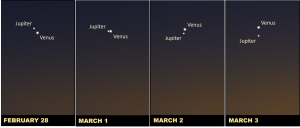The planets Venus and Jupiter, which are the two brightest objects in the night sky other than the Moon, will stage a spectacular close encounter in the western evening sky in late February and early March. They will slip past each other, with Venus climbing away from the Sun while Jupiter drops toward it. [Damond Benningfield/Stellarium]
You are here
Venus and Jupiter
The two brightest points of light in the night sky are staging a spectacular encounter. They’re low in the west at nightfall, and set an hour or so later. Venus is the brighter of the two — the “evening star.” Jupiter is a little above it tonight, but they’ll stand side by side tomorrow night — almost touching each other. They’ll stay fairly close for a few nights after that, but the gap will grow wider night by night.
Venus appears so bright because it’s close to Earth, it’s covered by bright clouds, and it’s close to the Sun, so it reflects a lot of sunlight into space.
Thanks to our always-changing viewing angle, the gap between Venus and the Sun will widen over the next few months. As a result, the planet will stand a little higher in the sky each evening until late June. It’ll be moving closer to Earth until August, when it will pass between us and the Sun.
Jupiter, on the other hand, is dropping toward the Sun. It will disappear in the evening twilight next month. Jupiter shines brightly in part because it’s the biggest planet in the solar system — roughly 11 times the diameter of Earth. And it, too, is covered by clouds. But its brightness is limited by its great distance — an average of almost half a billion miles.
Again, look for Venus and Jupiter hanging close together in the western sky not long after sunset — the brightest lights in the night sky.
More about Venus and Jupiter tomorrow.
Script by Damond Benningfield
Get Premium Audio
Listen to today's episode of StarDate on the web the same day it airs in high-quality streaming audio without any extra ads or announcements. Choose a $8 one-month pass, or listen every day for a year for just $30.







